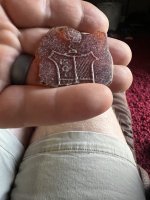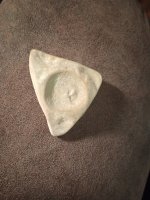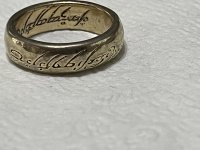You are using an out of date browser. It may not display this or other websites correctly.
You should upgrade or use an alternative browser.
You should upgrade or use an alternative browser.
Did I find a kettle point??
- Thread starter quackertracker
- Start date
Charl
Silver Member
More examples of brass and copper points from New England sites…

Buckleberry
Hero Member
- Sep 4, 2010
- 637
- 786
I've never heard the term, but immediately knew what it was referencing in the title.
Riverbum
Sr. Member
MAN thats a GOOD LOOKIN one, still trying to find me just ONE for my collection, They tell me to hunt around the various TRAILS going west during the pioneer days since native Americans would make these from WAGON WHEEL STAVES, rims, and other metal trash they'd find on those trailsThis is a Kettle Point.
View attachment 2046046
- Nov 3, 2018
- 2,713
- 5,774
- Detector(s) used
- O.G. XP DEUS
- Primary Interest:
- All Treasure Hunting
First time I heard the term "Kettle point" was on "Green Mountain Metal Detecting" on YouTube. Brad and his host were metal detecting a long time occupation site in New England. They were digging Kettle Points alongside beads, Pottery and Flint artifacts all in the same hole... Its my understanding the Kettle points were made from Kettles made of Pot Metal.I've never heard the term kettle point before either.
Older The Better
Silver Member
- Apr 24, 2017
- 3,137
- 5,816
- Detector(s) used
- Whites Eagle Spectrum
- Primary Interest:
- All Treasure Hunting
Well charl your evidence definitely makes me rethink the chances it is a trade metal point.
11KBP
Hero Member
I rarely find remnants of cast iron pots on historic Plains NA village sites. Most all of the trade vessels which included various sizes of pans and kettles were made of thin brass. The traders could place smaller sized brass vessels nestled in larger sized ones making a much lighter and smaller pack for transportation. Cast iron is very heavy to transport and definitely not suitable for recycling into NA-made arrowheads. However I have seen iron trade hoes with the thinner blades recycled into scrapers and points.Native Americans would often use broken cast iron pots and form arrowheads during the transition where they lost all their technology. That being said I have not seen one with a lobed base.
Charl
Silver Member
Yeah, seeing the indented base on the OP’s piece, and in examples from New England, gave me pause to think it possible.Well charl your evidence definitely makes me rethink the chances it is a trade metal point.
11KBP
Hero Member
Are these brass or copper points in your image European-made for trade or white traders-made points made for trade or are they Native American-made points made of recycled trade items?
joshuaream
Silver Member
Just for clarity, the term pot metal is usually that lead/zinc low melting point metal that cheap cast toys were made from in the 1900's. (Cowboys, Soldiers, cars, cap guns, etc.) It'll make a great musket ball, but it's too soft to be of much use as a thin point.First time I heard the term "Kettle point" was on "Green Mountain Metal Detecting" on YouTube. Brad and his host were metal detecting a long time occupation site in New England. They were digging Kettle Points alongside beads, Pottery and Flint artifacts all in the same hole... Its my understanding the Kettle points were made from Kettles made of Pot Metal.
The metal trade pots were made from brass, and occasionally copper. And most "kettle points" are made from brass or copper. Occasionally you see iron enamel ware points from California and Nevada, but those are typically post 1880's. (Probably salvaged from miner camps.)
- Nov 3, 2018
- 2,713
- 5,774
- Detector(s) used
- O.G. XP DEUS
- Primary Interest:
- All Treasure Hunting
Just going by what was said in the YouTube video Josh.
FWIW if I dug a kettle or trade point it would go in the trash sack becuase they just dont float my boat like Flint and Hardstone artifacts.
FWIW if I dug a kettle or trade point it would go in the trash sack becuase they just dont float my boat like Flint and Hardstone artifacts.

- Feb 3, 2009
- 37,402
- 138,641
- 🥇 Banner finds
- 1
- Detector(s) used
- Deus, Deus 2, Minelab 3030, E-Trac,
- Primary Interest:
- Relic Hunting
I guess what ever floats one's boat in collecting/finding.Just going by what was said in the YouTube video Josh.
FWIW if I dug a kettle or trade point it would go in the trash sack becuase they just dont float my boat like Flint and Hardstone artifacts.
For myself if I found a copper culture point/blade/spear point I'd be some


Hope that you reconsider your trash if you do dig a 1000-4000 yr old piece.
Charl
Silver Member
The photo illustrations are from Jeff Boudreau’s expanded typology. Jeff passed away several years ago now. He did state that in New England, most metal points recovered have been of native manufacture, and that by the second half of the 17th century, our local natives had become highly skilled metalworkers. That interpretation was seconded by archaeologist James Bradley, Director Emeritus of the Robert S. Peabody Museum of Archaeology.Are these brass or copper points in your image European-made for trade or white traders-made points made for trade or are they Native American-made points made of recycled trade items?
The Dutch had well established trading posts on the Atlantic coast of RI, and on Dutch Island, in Narragansett Bay, RI, prior to the English arrival at Plymouth. A great deal of trade was taking place, and in return, the Narragansett became the principal manufacturers and distributors of wampum, when it became a medium of exchange. Several Narragansett cemeteries from the 17th century have yielded an abundance of metal goods obtained in trade, from both the Dutch, and English.
11KBP
Hero Member
Thanks Charl,He did state that in New England, most metal points recovered have been of native manufacture, and that by the second half of the 17th century, our local natives had become highly skilled metalworkers. That interpretation was seconded by archaeologist James Bradley, Director Emeritus of the Robert S. Peabody Museum of Archaeology.
This is probably being nit-picking but I do have trouble with these NA-made points being called trade points. The NA made specimens made during the historic time period can have a distinctive style or shape sometimes unique to their culture unlike the typical style of the finished commercially made projectile points from the fur and hide traders. The NA's learned to make these points themselves by recycling any metal suitable to make the finished product. In other words I feel a historic era NA-made metal points deserve their own classification as they are much more unique than a commercially ready-made “trade point” which was made specifically for trading purposes.
Older The Better
Silver Member
- Apr 24, 2017
- 3,137
- 5,816
- Detector(s) used
- Whites Eagle Spectrum
- Primary Interest:
- All Treasure Hunting
Just kind of cleaning up some stuff, but I certainly have iron trade points from Kansas they weren’t all brass, but also are not likely pieces of cast, which brings me to the second minor issue I agree it’s important to differentiate between points manufactured for trade and those made by na’s that’s why I try to say trade “metal” points when speaking of both. Oddly enough I’d say the one brass one I do have could have been European manufacture and some iron ones could be na made.
Last edited:
Charl
Silver Member
Makes sense. After all, these are not really trade points that we are familiar with from elsewhere in North America, so there is that. It’s not an irrelevant distinction, I appreciate you pointing that out. I’m guessing it originated from the fact most were made from traded utensils. Kettles, as seen in the museum exhibit. So they originated in traded brass and copper, mostly arriving in the form of kettles. They do appear in all our local/regional typologies, as basically the last utilized projectile before there were no longer free living bands in southern New England.Thanks Charl,
This is probably being nit-picking but I do have trouble with these NA-made points being called trade points. The NA made specimens made during the historic time period can have a distinctive style or shape sometimes unique to their culture unlike the typical style of the finished commercially made projectile points from the fur and hide traders. The NA's learned to make these points themselves by recycling any metal suitable to make the finished product. In other words I feel a historic era NA-made metal points deserve their own classification as they are much more unique than a commercially ready-made “trade point” which was made specifically for trading purposes.
Boudreau’s description simply begins “Trade points were manufactured from copper, brass, bronze, iron, and steel. They were traded by the British, French, and others from the 1600’s on.” That can be seen as an incomplete description, as one can ask “manufactured by whom?” , as well as “traded as finished points or as metal utensils”? I think Boudreau was thinking in terms of both in that description, although that opening comment by Boudreau really sounds like actual trade points, as you describe them. So, that’s confusing.
But the European made ones, those that better fit the description “trade point’, are really post dating, for the most part, what was the case in southern New England, where there were no free roaming native bands(except raiders in the later French and Indian Wars, at which time, guns had replaced arrows) after 1676, following the defeat of the tribes in King Philip’s War. Boudreau illustrated, with his sample, what was the case here in the 17th century, namely mostly native made points, manufactured from European metal utensils. And the most common variety, a brass or copper Levanna, is a better label than “trade” point.
Last edited:
Charl
Silver Member
So, I have only surface found two native made metal points. Both plain triangles. They do show interesting traits, which I have seen in other such points, all 17th century, from Rhode Island and surrounding states.Thanks Charl,
This is probably being nit-picking but I do have trouble with these NA-made points being called trade points. The NA made specimens made during the historic time period can have a distinctive style or shape sometimes unique to their culture unlike the typical style of the finished commercially made projectile points from the fur and hide traders. The NA's learned to make these points themselves by recycling any metal suitable to make the finished product. In other words I feel a historic era NA-made metal points deserve their own classification as they are much more unique than a commercially ready-made “trade point” which was made specifically for trading purposes.
Something I have seen at times is what look like guide lines, incised in the sheet metal. This point I found is a slightly heavier stock than most, I wondered if made from a thicker piece of metal, like a hinge on the kettle. Here the point is clearly roughly cut, and the lines were not followed. At all, really. Looks like they were following a different line on the left side, where one can see the trace of a line at the left basal corner. Anyway, I’ve seen that quite a bit, the appearance of what look like lines to guide a cut. (Or, those lines were efforts to cut, and he changed his mind?).
This one puzzled me. Until I noticed other lopsided points, not always this extreme. And a write up of a lopsided brass triangle found on Boston Common years ago, during a professional dig. And a lightbulb went off, lol. They apparently cut a square or rectangle of sheet brass diagonally, to create two points from one square. Then, simply notch the wood shaft at an acute angle, such that the point could be slotted into the shaft in an upright position. (And I guess if used other than as a projectile, maybe lopsided was a little knife form). This was found on a saltwater sandbar, rather amazing, near the location of a large 17th century Narragansett village. Very thin sheet metal, which is typical…
Last edited:
Top Member Reactions
-
 2592
2592 -
 1181
1181 -
 1075
1075 -
 887
887 -
 855
855 -
 846
846 -
 789
789 -
 684
684 -
 640
640 -
 603
603 -
 490
490 -
 477
477 -
 475
475 -
 471
471 -
 464
464 -
 428
428 -
O
413
-
 396
396 -
 380
380 -
 374
374
Users who are viewing this thread
Total: 2 (members: 0, guests: 2)
Latest Discussions
-
-
-
Anyone have any idea what this means. Thanks for sharing any info
- Latest: E-Trac-Ohio
-







